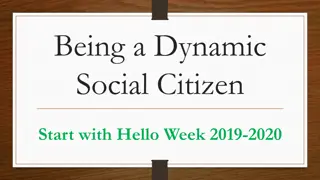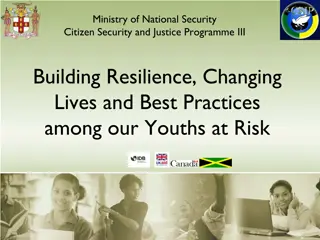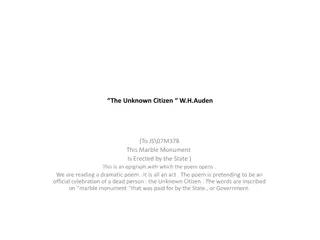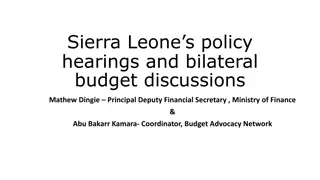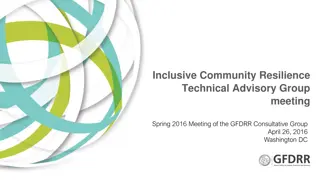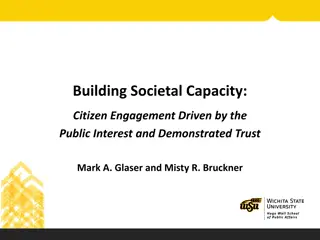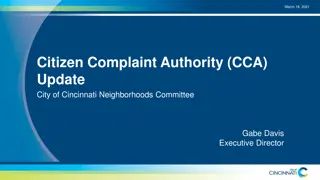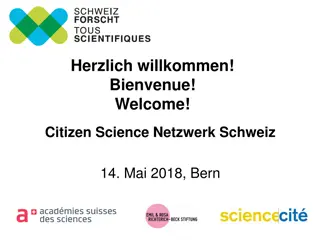Enhancing Citizen Engagement in Local Project Monitoring
Facilitating citizens' engagement in monitoring project implementation at the local level is crucial for ensuring transparency and efficiency. Actors like BIGD, NGOs, engineers, and citizens committees play key roles in this process. The scope includes monitoring projects in Rangpur and Sirajganj districts, focusing on roads and schools. The methodology involves thorough preparation for field visits, collaboration with engineers, feedback loops, and creating a virtuous cycle for improved project outcomes.
Download Presentation

Please find below an Image/Link to download the presentation.
The content on the website is provided AS IS for your information and personal use only. It may not be sold, licensed, or shared on other websites without obtaining consent from the author.If you encounter any issues during the download, it is possible that the publisher has removed the file from their server.
You are allowed to download the files provided on this website for personal or commercial use, subject to the condition that they are used lawfully. All files are the property of their respective owners.
The content on the website is provided AS IS for your information and personal use only. It may not be sold, licensed, or shared on other websites without obtaining consent from the author.
E N D
Presentation Transcript
BRAC Institute of Governance and Development (BIGD) BRAC University
Objective Facilitating citizens engagement in monitoring project implementation at the local level (Upazila and Union) so project implementation process becomes transparent and consequently efficient Actors and their role BIGD: design of the intervention strategy; providing analytical support (research, documentation, dissemination of lessons learnt), help capacity building of the partner NGOs and overall coordination of the program NGOs: capacity building, nurturing and guiding the Citizen Committees at the local level Engineers: providing technical support to the NGOs and Citizens Committee Citizens Committees: exacting social accountability of the contractors through systematic monitoring of the project activities
Scope and Nature of Interventions Sites Two Upazilas (Sadar and Mithapukur) in Rangpur district and two Upazilas (Sadar and Belkuchi) in Sirajganj district Nature of projects Number of projects being monitored in each Upazila: 3 roads and 2 schools Roads: 1 Upazila, 1 Union and 1 village Schools: new construction and expansion of the existing building In total 6 roads and 4 schools in each district Total Project: 12 roads and 8 schools
Methodology of Committee Intervention Good preparation for the field visits: 1. collect specifications; 2. meeting engineers to discuss monitoring strategies and methods/techniques and to know the current status of the project This leads to productive site visits: Committee is reasonably informed and technically more equipped to efficiently monitor projects Then revisit engineers: sharing information/observations of the conditions of the project with the Upazila engineers That generates useful feedback loop: engineers receive reliable feedback to evaluate contractor s performance more accurately and to instruct him for taking remedial measures Which creates a virtuous cycle: contractors tend to be more responsive to Committee s observations/queries during subsequent visits and more willing to effect desired changes in the projects
Effecting changes in the project operations: Overall quality of the projects (both school and road) have improved. Contractors are being compelled to follow the specification of the projects Contractors/field managers/supervisors are becoming increasingly responsive to citizens queries Citizen Committees positive impact on the local community: Local people are increasingly taking interest in the projects Such attention of the local community is forcing the contractors to use better quality materials
Demystification of technical dimensions of the project is needed and not that difficult to accomplish Mystifications happen through: Project specifications are in English language Engineering jargons Contractors/managers and even head laborer show excuses of technical complications of the project to resist accountability to the general citizens Documents are not available at the site. Local citizens are told to collect these from the Upazila LGED office
Demystification is possible Committee members easily understood the stages in constructions (discussion with the engineers and inclusion of former engineers, contractors in the Committee also helped) People tend to have knowledge (local knowledge) about the quality of the materials (perhaps due to prior experiences as laborer, supervisor, contractor, supplier of materials etc) Such knowledge also include reasonably precise understanding of the ratio of sand and brick pieces, method of mixing, correct width of rods, correct weight of rollers, necessity of the use of water etc Local people want to validate their knowledge with the authority, which is, presently, quite difficult if not impossible Project interventions have led to quick learning by the Committee members in relation to box cutting, rod binding, ratio of mixing sand and cement etc
Severe deficit of trust and social capital Deficit in social capital means, community not cohesive, individuals with leadership potentials are prone to opportunism, community network more hierarchical rather than horizontal Lack of trust among stakeholders can be understood from the following perceptions of the actors: Citizen: Contractors can never be trusted Engineers can also be corrupt and may work in collusion with the contractors Contractors: Citizen initiatives are always driven by ulterior motives Citizens will extort the contractors in any case, whether the job is done properly or not Such extortions community (donations for local institutions club, mosque etc) will be carried out individually or on behalf of the proximate
How trust can be generated? Through access to essential information related to the project (specification, standard of materials, etc) Will result in lowering the expectation of the citizen regarding the standard of the project Repeated interactions between engineers and the citizens, assuming that these will contribute to increased efficiency and transparency in projects, may generate trust Social Capital is therefore , not amenable to short term project intervention largely immutable (may evolve over the long run)and We will have to live with the existing forms of social capital. This means, designing of the intervention needs to adapt with the existing socio-political reality
Limits of elite mobilization: Although participating citizens are reasonably motivated (with certain degree of variations within the districts)and collective action interventions generating positive outcomes, but it is not operating in a natural setting heavily nurtured and guided by external actors Strength and reputation of the Committee is somewhat based on members social status but mainly derived from its association with the state actors (to a large extent) and NGO (to a certain extent) Project fund plays an important role mobilizing elite members of the community
Left on its own, incentives for collective action will be largely constrained by the following factors: Weak sense of ownership (projects being observed are not proximate to the members; members are not direct beneficiaries; caring for public goods is generally a weak motivating factor for free riding actors) Transaction costs/opportunity costs (travel, time, political risks) also create disincentives for the members Existence of potential conflict of interests (elites and contractors tend to be connected socially and occasionally through kinship) This means, current incentive structure of the members can hardly be defined as a self- reinforcing equilibrium The bottom line is: Sustainability (political, social, economic) of the project remains uncertain
Rationales for rethinking a new strategy There is a need to design intervention strategy in a way, which can address the incentive problems and financial sustainability, as discussed earlier This will entail addressing the issues of trust, social capital, access to information, sense of ownership, free riding, transaction costs for individual citizens and project costs Site Specific Community Mobilization This is a minimalist strategy with only two actors: engineers and local citizens, who live adjacent to the site of the projects
Site Specific Community Mobilization Citizen-monitors who live adjacent to the sites tend to have different incentive structure, which enables relatively robust form of collective action: Free riding: public goods become de facto private goods; increased sense of ownership ; Transaction costs for monitoring will be reduced substantially Intervention strategy can tactically avoid the larger factors such as social capital or elite political influence, which tend to make project design messy or vulnerable to political economy constraints The new strategy will not incur any project costs since there are no NGOs to facilitate, no offsite citizen groups, which needs to be trained or nurtured. To put it succinctly, there is no Project in this strategy and, therefore, no question about project sustainability will arise
Minimal requirements for the strategy to work: Commitment from the state/procurement entities (PE) to provide project relevant information , in a demystified way, to the local community Such information must include: specification of the job written in simple Bangla; a document explaining the techniques to sort out good construction materials from the sub standard ones; and simple instructions to monitor construction process such as proper ratio of mixing materials and width of rods, placing of rods and so on Erecting billboard project at the site describing the essential information of the Institutionalization of easy flow of communication between the PE and local community throughout the project period Such information dissemination will help reduce trust related problems , which is deeply embedded in the psyche of the community





